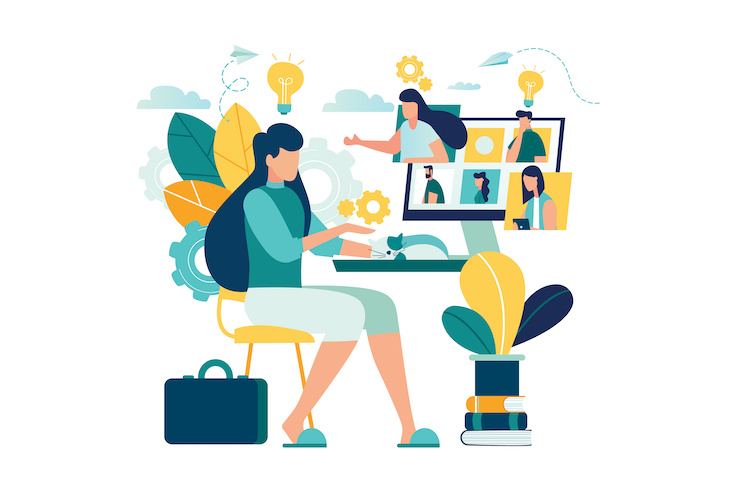
The disruption brought on by the shift to hybrid work provides excellent opportunities for experiential learning. By balancing intentionality with support and maximizing the quantity, quality and diversity of learning experiences, both organizations and individual leaders can adapt and thrive in this new era of work.
by George Hallenbeck
March 4, 2022
Experience-driven approaches to development, especially stretch assignments and other forms of on-the-job learning, are a centerpiece of many organizations’ efforts to grow versatile and agile leadership talent. Experience is indeed the best teacher.
However, the shift to remote work has complicated traditional approaches to experiential learning. Physical separation and increases in asynchronous work reduce the frequency and diversity of interactions, make day-to-day leader behaviors and activities less visible, and create barriers to getting immediate feedback and other forms of support, including mentoring.
Leading and teaming are difficult even under “normal” circumstances. Hybrid work adds considerable complexity because each employee’s experience will differ greatly depending on their individual work status. Everyday advantages, disadvantages, needs and concerns are shaped by whether an employee is primarily on-site, primarily remote or splitting time between the two.
For example, a remote worker may enjoy the flexibility and freedom this arrangement offers but experience concern that their contributions won’t be as recognized as those who are on-site. Likewise, an on-site worker can freely engage in spontaneous interactions and readily display their accomplishments but may feel stress about not being able to manage their time and obligations the same way a remote worker can. An employee can experience the best of both worlds to some degree with a combination of on-site and remote work but may feel challenged by the need to switch between the two work modes.
The clash of these differing realities offers great opportunities for learning, especially if you’re responsible for leading a hybrid team and must align team members into a shared, cohesive experience where everyone feels valued and included. The same conditions also present threats to learning by making essential components such as communication, collaboration and trust harder to sustain.
Seizing the opportunities while mitigating the threats requires a multifaceted, integrated approach. Focus on these five elements of an experience-driven learning ecosystem.
1. Quality of a learner’s experiences
Experiences vary significantly in the amount of learning they may yield for an individual. For an experience to generate learning, a certain amount of “heat” must be present to shift the learner out of their comfort zone and into a setting that forces them into new ways of seeing, thinking, feeling and acting in order to adapt and grow.
Center for Creative Leadership research has identified 10 distinct elements that contribute to developmental heat. The more of these present in any given experience, the greater potential for the quantity, depth and breadth of lessons that might be learned. Fortunately, hybrid work experiences naturally lend themselves to learning as many likely contain heat elements such as new directions, unfamiliar responsibilities, work group diversity and influence without authority. If anything, the physically dispersed and often asynchronous nature of hybrid work elevates the heat level by making it harder to connect and align.
2. Diversity of a learner’s experiences
Different experiences teach different things. Lessons of experience typically fall into three buckets: things we learn about working, things we learn about others and things we learn about ourselves. Depending on the nature of the experience, different buckets might be filled in varying amounts and with altogether unique lessons learned. What one learns from launching a new product with a cross-functional team and what one learns from leading the effort to get a failed software implementation back on track are quite different.
CCL has identified 15 distinct types of learning experiences that leaders typically encounter, including new initiatives, turnarounds, increases in job scope and working with difficult people. The hybrid work environment can encapsulate all these types of experiences and might make some of them, such as an increase in job scope as part of hybrid transformation, more likely to occur. Conduct regular check-ins as team members take on expanded responsibilities to ensure the heat doesn’t cross into burnout.
3. Quantity of a learner’s experiences
After a leader has gone through an experience and had time to reflect upon and apply what they learned, development tends to level off — unless, of course, another experience that is both high in quality and different in nature soon occurs. Individuals need a steady diet of different experiences in order for their growth to remain dynamic and for the lessons of experience to compound and form a rich web of learning.
The dynamic and evolving nature of the hybrid workplace should lend itself to generating new learning experiences for leaders to engage in. Nonetheless, be on the lookout for any signs that leaders are becoming complacent or stuck in a rut.
4. Intentionality of the learning environment
Your organization can strongly influence the learning environment — so don’t leave it to chance. Valuable learning experiences are often created and managed in an intentional manner, with a keen eye for the intersection of the strategic needs of the organization and the developmental needs of the individual.
Many leaders participating in CCL’s developmental research observed that their most profound learning experiences were seldom of their own choosing or preference; they were often assigned to them and initially perceived to be unfavorable. This bold approach to development requires both parties to assume some risk and trust in one another. Hybrid learning already has a great deal of uncertainty and risk associated with it, so this is a good opportunity to put that front and center in an intentional way and build trust with team members.
5. Support offered in the learning environment
Learning does not follow a straight path — it proceeds unevenly, involves struggle as leaders adapt to the heat of the experience and includes (essential) mistake-making. It’s critical that your organization provides active support from multiple sources to build the trust necessary for the learner to develop.
Your team members should be given sufficient autonomy to immerse and stretch themselves, with a safety net in place that ensures mistakes don’t become career-stalling blunders and that the heat of the experience doesn’t erode psychological safety or resilience. Active support from the boss and the organization can include progress check-ins to make sure learning (and organizational) goals are being met, ongoing dialogue about what can be learned and applied from the experience, and feedback and coaching that turn mistakes into learning opportunities.
Surrounded by experience, surrounded by learning
These five elements can be applied in a backward- and forward-looking manner. Examine the data for patterns among leaders to detect what specific experiences have generated the most learning and use this insight to formulate future learning opportunities. Looking forward, consider the individual and collective gaps that need to be filled in leadership profiles and prioritize which experiences should come next to strategically develop leaders.
One of the simultaneously great and frustrating aspects of learning from experience is that experience is present all the time, just waiting to be leveraged for new insights and continued growth. The challenge is to seize it for all it has to offer in the moment, rather than focusing on “getting through it” and moving on. The disruption brought on by the shift to hybrid work provides excellent opportunities for learning from experience. By balancing intentionality with support and maximizing the quantity, quality and diversity of learning experiences, both organizations and individual leaders can adapt and thrive in this new era of work.




